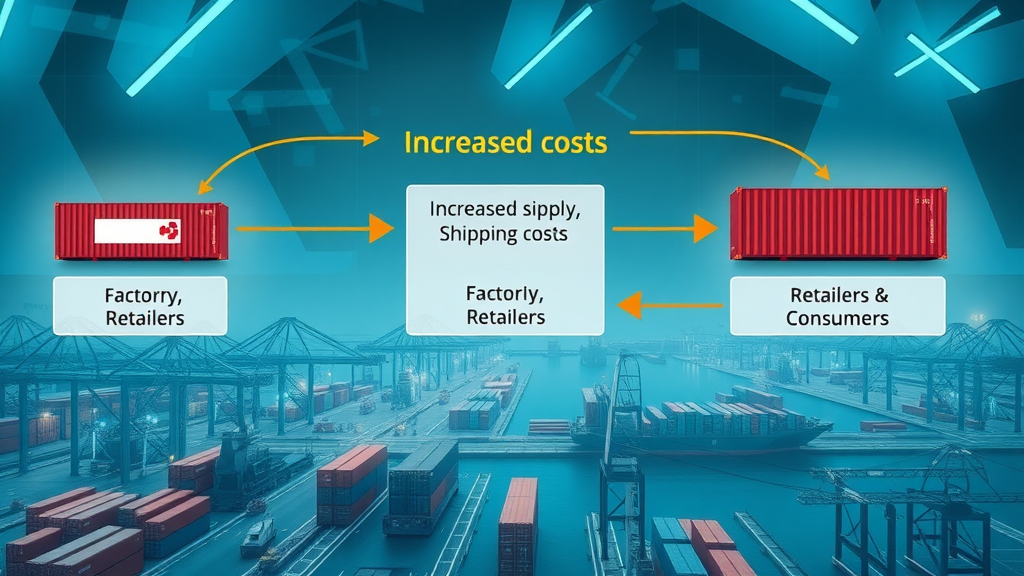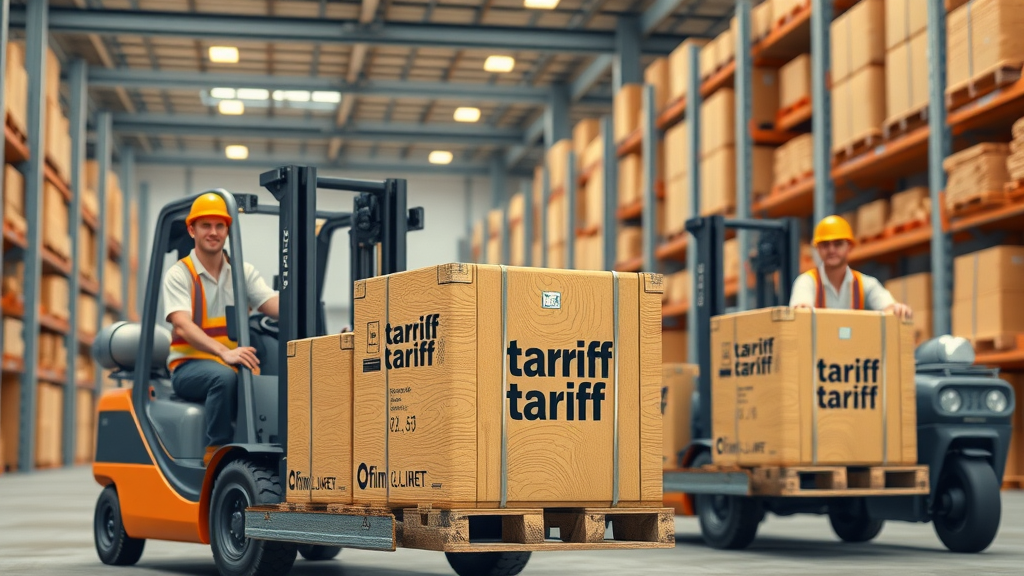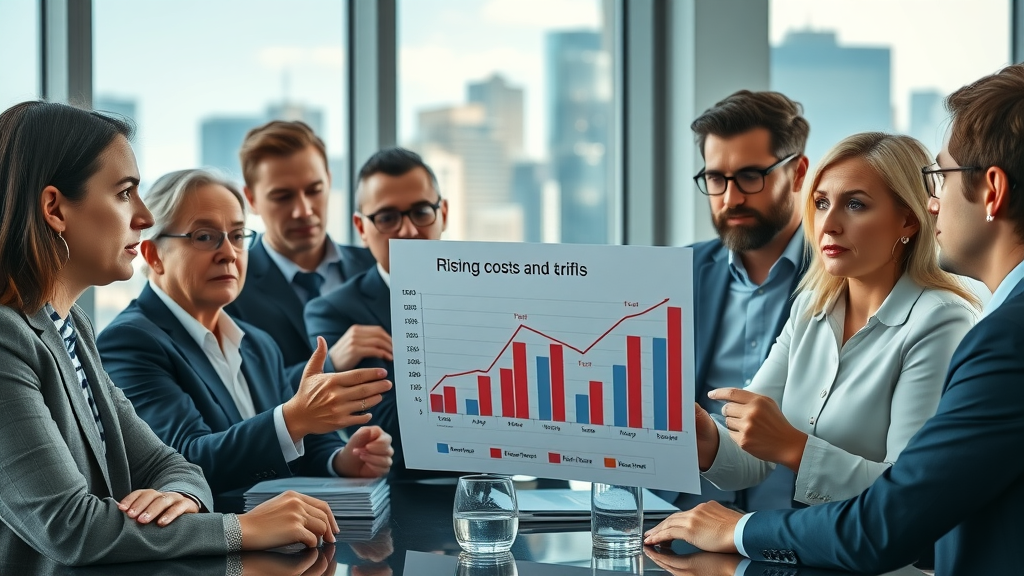Did you know that in 2018, U.S. tariffs cost consumers and businesses over $69 billion, pushing inflation to its highest point in nearly a decade? Few financial policy levers have the unseen—and often devastating—impact on household budgets like tariffs. While many assume these taxes hit only foreign producers, the reality is far more jarring: the true cost of tariffs ricochets through the economy, hiking prices not just for businesses but for everyday essentials in your shopping cart. If you’ve felt the pinch of price hikes lately, you’re not alone. This article pulls back the curtain on the shocking connections between trade barriers and inflation, unpacking the complex chain of reactions felt from the consumer price index to your wallet.
A Startling Look at Inflation Caused by Tariffs
When policymakers implement tariffs, their aim is often to shield domestic industries or respond to international disputes. Yet the impact of tariffs goes far deeper than simple policy maneuvers. At its core, inflation caused by tariffs is a phenomenon where prices rise not because of increased demand or scarcity, but because extra costs are layered onto goods at every step—first as imported goods cross borders, and then as these costs ripple through suppliers, retailers, and ultimately, consumers. For American families, this translates directly to price hikes on a wide range of everyday items, from clothes to electronics and even groceries.
Consider this: in just one year after the Trump administration ratcheted up tariffs, the Bureau of Labor Statistics noted significant jumps in the consumer price index , particularly for products like washing machines and electronics. Businesses, caught in a squeeze between rising input costs and competitive pricing, often have little choice but to pass these costs along—or risk losing profitability. The result? A higher price level across the economy, with long-term consequences for both growth and family budgets.

"In 2018, U.S. tariffs cost consumers and businesses over $69 billion, pushing inflation to its highest point in nearly a decade."
Unpacking the Inflation Caused by Tariffs: Key Insights and What You'll Learn
- How inflation caused by tariffs directly affects consumers, businesses, and the broader economy
- Clear examples of how tariff costs are passed down the supply chain
- Insightful analysis of trade policies and their unintended side effects
- Evidence, statistics, and expert opinion on the true impact of tariffs
- Actionable takeaways for navigating inflationary environments
The Direct Impact of Tariffs on Inflation: Understanding the Mechanisms
Inflation caused by tariffs stems from a very tangible mechanism: when governments raise tariff rates on imported goods, the added fees are rarely absorbed by foreign exporters. Instead, these tariff costs are paid upfront by importers and ultimately shift directly onto businesses and consumers, often causing a broad-based price increase across entire sectors. For instance, a higher tariff on steel doesn’t just boost the cost of raw metal—it also makes automobiles, appliances, and even canned groceries more expensive to produce and purchase.
Major economic indicators like the consumer price index and the producer price index often reflect these changes almost immediately. Recent research from the Federal Reserve and numerous chief economist reports has found that increases in tariff rates correlate strongly with spikes in both wholesale and consumer prices. In some notable cases, such as the 2018-2019 tariffs on Chinese imports, consumer electronics and home goods saw prices rise by double-digit percentages, dramatically outpacing wage growth and disproportionately affecting lower-income families.

Tariff Costs and the Consumer Price Index
One of the clearest indicators of inflation caused by tariffs is the persistent climb in the consumer price index (CPI), which tracks the average prices consumers pay for a basket of goods and services. Each time a new round of tariffs is announced, companies recalibrate their costs, often leading to price hikes across the board. According to the Bureau of Labor Statistics , after the Trump administration's tariffs took effect, prices rose significantly for items like washing machines—climbing nearly 20% in a single year. These increases weren’t isolated; downstream products containing tariffed materials (like imported steel or aluminum) also spiked, illustrating that tariff costs permeate the economy well beyond the products initially targeted by policy.
There’s also a compounding effect: as tariffs make certain goods more expensive, production costs rise for a wide swath of manufacturers, leading to even broader price increases in the following months. Over time, this can destabilize the price index , push consumer spending downward, and erode purchasing power, especially for those living paycheck to paycheck. As the cycle continues, the inflationary impact can become entrenched, making it harder for policy changes or interest rates adjustments to offset the initial shock.
Supply Chain Reactions to Tariff-Driven Inflation
The global supply chain is a delicate web of interconnected producers, shippers, wholesalers, and retailers. When tariffs disrupt one link, the resulting shockwaves can be felt around the world. Higher import costs force manufacturers to make tough choices: eat the new fees, reduce product quality, or implement price hikes , which ultimately land at the consumer’s feet. This cascading effect is especially evident in goods with complex supply chains, such as electronics, automobiles, and machinery, where multiple foreign-supplied components bear separate tariffs.
Importers and downstream manufacturers often try to absorb some costs, but persistent or steep tariffs can overwhelm even the best-managed businesses, leaving no option but to pass along the increase. This not only heightens inflation but can create unexpected market distortions: some U.S. industries become less competitive globally, while others, shielded from foreign competition, may raise their own prices. In every scenario, the risk of market inefficiencies and reduced consumer choice grows, amplifying the overall impact of tariffs far beyond their intended scope.

Historical Lessons: Major Cases of Inflation Caused by Tariffs
Understanding the legacy of inflation caused by tariffs requires a look at history’s most disruptive trade interventions. Take the infamous Smoot-Hawley Tariff Act of the 1930s: designed to protect American agriculture and manufacturing, it instead triggered a global cascade of retaliatory tariffs, leading to steep price hikes and a collapse in international trade. U.S. consumer prices and personal consumption expenditures plummeted, exacerbating the Great Depression and leaving economic scars that endured for decades.
Fast forward to more recent times, and the story is much the same. The 2018-2019 U.S.-China trade war led to dramatic imported good price increases, as well as shortages and logistical snarls along the supply chain . Price levels soared for countless categories, and reports from both the Federal Reserve and Wall Street analysts documented widespread consumer pushback over higher costs for essential goods and services. Each instance confirms a crucial lesson: while tariffs may provide short-term political cover, they rarely deliver sustained benefit without significant collateral damage.

| Tariff Event | Immediate CPI Impact (%) | Long-Term Consumer Price Increase (%) | Market/Wage Reaction |
|---|---|---|---|
| Smoot-Hawley (1930) | +7.2 | Persistently high prices until tariff rollback | Sharp wage cuts, reduced consumption |
| US Steel/Aluminum Tariffs (2018) | +4.5 | ~8-10 in select categories | Falling manufacturing exports |
| China Tariffs (2018-2019) | +8.1 | Double-digit rises in electronics and machinery | Supply chain bottlenecks, profit squeezes |
How Trade Policy Intensifies Inflation Caused by Tariffs
The relationship between trade policy and inflation is anything but straightforward. When nations veer toward protectionism, the intended goal is typically to safeguard domestic jobs and industries, but the trade-off is almost always higher costs for business and consumers. High tariffs disrupt established trading flows and inject volatility into global supply chains ; over time, these disruptions can spiral into sustained cost inflation, fueling debate at the highest levels of economic policy.
Conversely, free trade agreements are proven to bolster competitive pricing and keep inflation at bay, as they remove artificial borders and encourage the efficient allocation of resources. The challenge, of course, is balancing the interests of groups that benefit from protection with those who benefit from open markets. As recent experience shows, failure to strike that balance can mean significant pain at the checkout counter—and lasting political fallout.
Protectionism vs Free Trade: Inflationary Outcomes
At the heart of the inflation debate is the choice between protectionism and free trade. Protectionism, fueled by higher tariffs, almost always leads to upward price pressure by restricting market access and reducing competition. For example, following recent U.S. tariff increases, consumer prices on imported electronics and auto parts saw sharp upward swings, confirmed by the consumer price index and Wall Street analyses.
By contrast, free trade encourages producers to innovate and keep price levels in check. When the U.S. and its global partners have removed barriers through trade agreements, data from the Federal Reserve has repeatedly shown slower price growth and greater diversity in affordable goods and services. The clearest conclusion? A move toward protectionist trade policy delivers inflation as a near-certain consequence.

"Raising tariffs is not just about protecting jobs—it’s about accepting higher inflation as a trade-off." – Senior Policy Analyst
Case Study: U.S.-China Trade War and Global Supply Chain Shocks
The U.S.-China trade war stands as a cautionary tale about the unintended consequences of aggressive tariff policy. In 2018, American tariffs on more than $250 billion worth of Chinese goods—and Chinese retaliation in kind—set off a chain reaction felt worldwide. U.S. manufacturers relying on imported goods found themselves squeezed by abrupt cost increases, while global supply chains scrambled to adapt to shifting trade flows and sourcing challenges.
The impact rippled outward: researchers noted widespread price hikes in electronics, clothing, and machinery as businesses struggled to absorb or pass on new tariff costs . In some sectors, these increased costs prompted offshoring, layoffs, or even company closures. Meanwhile, American consumers faced an implicit “tariff tax” on thousands of products, fueling debate from the White House to Wall Street over the wisdom and effectiveness of buy-American policies in a globalized world.
Breaking Down Tariff Costs: Winners, Losers, and Unexpected Consequences
While domestic producers may benefit in the short term from tariffs designed to shield them, the broader tapestry of winners and losers is far more complex—and concerning. Importers and downstream manufacturers often absorb part of the tariff costs , but over time, spreading these costs is unsustainable and leads to persistent price hikes .
Ultimately, it’s the consumer who bears the brunt: studies from the Federal Reserve , the Bureau of Labor Statistics , and multiple chief economist offices confirm that the lion’s share of tariffs is passed on through the price index , landing directly in family budgets as steeper grocery bills, higher electronics prices, and costlier cars. Worse, long-term market distortions can arise: industries protected by tariffs may become insulated, less efficient, and more likely to raise prices over time, stifling innovation and competition.
- Domestic producers shielded by tariffs may benefit—at the consumer’s expense
- Importers and downstream manufacturers routinely absorb higher costs
- Consumers inevitably pay more for goods
- Long-term market distortions and inefficiencies abound

| Stakeholder | Share of Tariff Costs Absorbed (%) | Common Response |
|---|---|---|
| Producers (Domestic) | 10-20% | Limited price increases, higher profits (short-term) |
| Importers/Manufacturers | 30-40% | Squeezed margins, shift sourcing |
| Consumers | 40-60% | Higher retail prices, reduced purchasing power |
People Also Ask: The Top Questions on Inflation Caused by Tariffs
What are the main causes of inflation?
Inflation is generally caused by factors such as increased demand for goods and services, rising production or input costs, and expansionary monetary policies. Tariffs fuel cost-push inflation by directly increasing the price of imported goods , consequently raising the overall price index . When businesses confront higher import expenses due to tariffs, they often pass those costs along the supply chain , resulting in price hikes for consumers and businesses alike.
How does free trade affect inflation?
Free trade typically reduces inflationary pressures by allowing for greater market competition, diverse sourcing, and efficient resource allocation. Without artificial barriers, goods and services can flow freely, helping to keep price levels stable or even reduce them through competition. In contrast, protectionist policies like tariffs restrict supply and raise prices, leading to higher inflation as evidenced by changes in the consumer price index during periods of heightened trade barriers.

What are the three main effects of tariffs?
Tariffs generally have three major effects: increasing the prices of imported goods , shifting market advantages to domestic producers, and reducing overall consumer choice. The combination of higher tariff costs and restricted imports tends to dampen competition and drive up retail prices, which negatively impacts consumers and downstream manufacturers within the supply chain .
What are the negative effects of trade tariffs?
The negative effects of trade tariffs include widespread price hikes for consumers and businesses, inefficiencies in the global supply chain , and persistent inflationary pressure. Tariffs also risk retaliation from other countries, reduced export opportunities, and long-term distortions in market behavior, underscoring the pitfalls of poorly calibrated trade policy .
Expert Opinions and Public Debate on Inflation Caused by Tariffs
Economists, policymakers, and business leaders remain sharply divided on the role of tariffs in national economic policy. While some support tariffs as a means to protect strategic industries or reduce dependency on foreign sources, the majority of experts—including those at the Federal Reserve —warn about severe inflationary consequences. The consensus is clear: tariffs act as a hidden tax, eroding purchasing power and amplifying cost-of-living challenges for ordinary citizens. Public debate continues to rage from the halls of Congress to financial newsrooms, with both the White House and Wall Street weighing the risks and rewards of trade interventions.
"Tariffs are a hidden tax that erode purchasing power and stoke inflation." – World Trade Journal

Practical Solutions for Mitigating Inflation Caused by Tariffs
- Diversify sourcing and engage in international negotiations to minimize reliance on high-tariff countries
- Implement targeted subsidies for industries most at risk of competitive disadvantage
- Promote transparency in tariff policy to reduce business uncertainty and prevent abrupt cost shocks
Each of these strategies aims to soften the blow of abrupt price increases and steady the market, ensuring companies and consumers alike are better prepared for policy-driven shocks. Governments and businesses must actively plan for these disruptions, leveraging innovative sourcing and smarter policy to protect economic stability.
Summary: The True Legacy of Inflation Caused by Tariffs

When tariffs are used as a blunt instrument, inflation and market instability often follow—hurting consumers, distorting industries, and locking in higher costs long after the policy debate has moved on. The future depends on wiser, more balanced trade policy decisions—and public awareness can help drive change that protects everyone’s bottom line.
Frequently Asked Questions About Inflation Caused by Tariffs
-
How do tariffs specifically contribute to inflation in my country?
Tariffs contribute to inflation by raising the cost of goods and services that rely on imported materials. These costs are usually passed through the supply chain and reflected in consumer prices. -
Are there any circumstances where tariffs reduce inflation?
It's rare, but if tariffs are implemented against goods flooding the market at abnormally low prices, they might stabilize prices—though overall, they more commonly drive inflation. -
How can businesses prepare for inflationary shocks driven by tariffs?
Businesses should diversify suppliers, simulate tariff scenarios, and maintain agile supply strategies to quickly adapt to changes in trade policy . -
Which sectors are most vulnerable to inflation caused by tariffs?
Sectors reliant on foreign inputs—such as manufacturing, electronics, and automotive—are particularly susceptible to tariff-driven price hikes. -
Can trade deals be structured to avoid inflation spikes?
Yes, thoughtful trade agreements can minimize tariff-induced shocks and help maintain stable inflation by preserving open markets and reducing unpredictable policy shifts.
Share Your Voice: Shaping the Future of Trade Policy
Have insights to share on global trade? Let's talk—call us at 203-271-7991 to explore contributing an article.
Tariffs, by design, increase the cost of imported goods, leading to higher prices for consumers and businesses. This phenomenon, known as cost-push inflation, occurs when the added expenses from tariffs are passed down the supply chain, resulting in elevated prices for a wide range of products. For instance, the 2018 tariffs on imported washing machines led to a price increase of approximately $86 per unit, with dryers—though not directly tariffed—also seeing a price hike of about $92 per unit due to market dynamics. ( govfacts.org )
The Smoot–Hawley Tariff Act of 1930 serves as a historical example of how protectionist policies can exacerbate economic downturns. By raising tariffs on over 20,000 imported goods, the act aimed to protect domestic industries but instead contributed to a significant decline in international trade, deepening the Great Depression. ( en.wikipedia.org )
In recent years, the U.S.-China trade war has further illustrated the inflationary impact of tariffs. Tariffs on Chinese imports have led to increased prices for consumer electronics, with estimates suggesting that a 60% tariff could raise laptop and tablet prices by up to 46%, and smartphone prices by up to 26%. ( en.wikipedia.org )
Economists emphasize that tariffs are inherently inflationary, as they impose additional costs on imported goods, which are often passed on to consumers. Federal Reserve Chair Jerome Powell noted that tariffs are expected to raise the U.S. inflation rate, highlighting the direct link between trade policies and consumer prices. ( cnbc.com )
Understanding the relationship between tariffs and inflation is crucial for policymakers and consumers alike. While tariffs may aim to protect domestic industries, they often lead to higher prices and can have unintended economic consequences.
 Add Row
Add Row  Add
Add 




Write A Comment